matlab实验
matlab数学实验
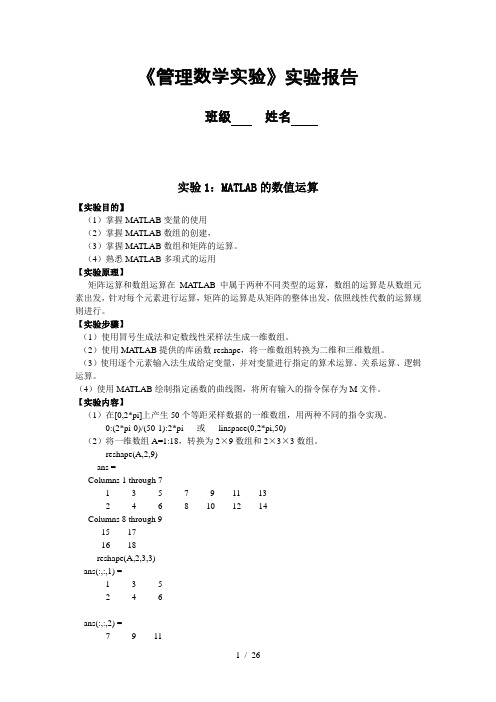
《管理数学实验》实验报告班级姓名实验1:MATLAB的数值运算【实验目的】(1)掌握MATLAB变量的使用(2)掌握MATLAB数组的创建,(3)掌握MA TLAB数组和矩阵的运算。
(4)熟悉MATLAB多项式的运用【实验原理】矩阵运算和数组运算在MA TLAB中属于两种不同类型的运算,数组的运算是从数组元素出发,针对每个元素进行运算,矩阵的运算是从矩阵的整体出发,依照线性代数的运算规则进行。
【实验步骤】(1)使用冒号生成法和定数线性采样法生成一维数组。
(2)使用MA TLAB提供的库函数reshape,将一维数组转换为二维和三维数组。
(3)使用逐个元素输入法生成给定变量,并对变量进行指定的算术运算、关系运算、逻辑运算。
(4)使用MA TLAB绘制指定函数的曲线图,将所有输入的指令保存为M文件。
【实验内容】(1)在[0,2*pi]上产生50个等距采样数据的一维数组,用两种不同的指令实现。
0:(2*pi-0)/(50-1):2*pi 或linspace(0,2*pi,50)(2)将一维数组A=1:18,转换为2×9数组和2×3×3数组。
reshape(A,2,9)ans =Columns 1 through 71 3 5 7 9 11 132 4 6 8 10 12 14Columns 8 through 915 1716 18reshape(A,2,3,3)ans(:,:,1) =1 3 52 4 6ans(:,:,2) =7 9 118 10 12 ans(:,:,3) =13 15 17 14 16 18(3)A=[0 2 3 4 ;1 3 5 0],B=[1 0 5 3;1 5 0 5],计算数组A 、B 乘积,计算A&B,A|B,~A,A= =B,A>B 。
A.*Bans=0 0 15 121 15 0 0 A&Bans =0 0 1 11 1 0 0 A|Bans =1 1 1 11 1 1 1~Aans =1 0 0 00 0 0 1A==Bans =0 0 0 01 0 0 0A>=Bans =0 1 0 11 0 1 0(4)绘制y= 0.53t e -t*t*sin(t),t=[0,pi]并标注峰值和峰值时间,添加标题y= 0.53t e -t*t*sint ,将所有输入的指令保存为M 文件。
高等数学:MATLAB实验

MATLAB实验
2.fplot绘图命令 fplot绘图命令专门用于绘制一元函数曲线,格式为:
fplot('fun',[a,b]) 用于绘制区间[a,b]上的函数y=fun的图像.
MATLAB实验 【实验内容】
MATLAB实验
由此可知,函数在点x=3处的二阶导数为6,所以f(3)=3为 极小值;函数在点x= 1处的二阶导数为-6,所以f(1)=7为极大值.
MATLAB实验
例12-10 假设某种商品的需求量q 是单价p(单位:元)的函 数q=12000-80p,商 品的总成本C 是需求量q 的函数 C=25000+50q.每单位商品需要纳税2元,试求使销售 利润达 到最大的商品单价和最大利润额.
MATLAB实验
MATLAB实验
MATLAB实验
MATLAB实验
MATLAB实验
MATLAB实验
MATLAB实验
MATLAB实验
MATLAB实验 实验九 用 MATLAB求解二重积分
【实验目的】 熟悉LAB中的int命令,会用int命令求解简单的二重积分.
MATLAB实验
【实验M步A骤T】 由于二重积分可以化成二次积分来进行计算,因此只要
MATLAB实验
MATLAB实验
MATLAB实验
MATLAB实验
MATLAB实验
实验七 应用 MATLAB绘制三维曲线图
【实验目的】 (1)熟悉 MATLAB软件的绘图功能; (2)熟悉常见空间曲线的作图方法.
【实验要求】 (1)掌握 MATLAB中绘图命令plot3和 mesh的使用; (2)会用plot3和 mesh函数绘制出某区间的三维曲线,线型
MATLAB全部实验及答案
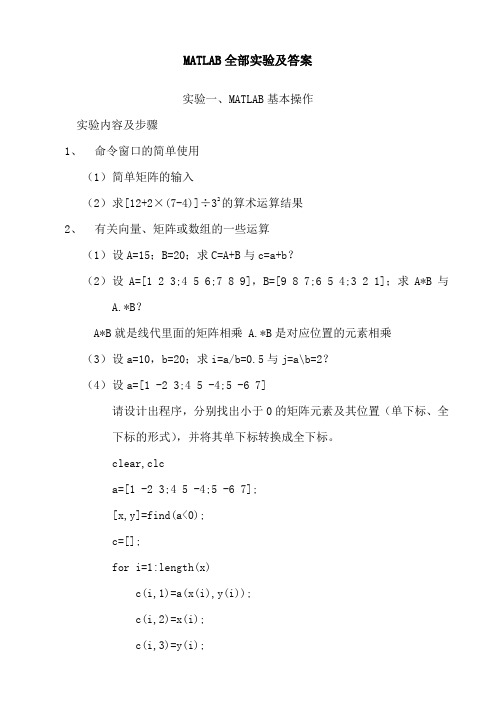
MATLAB全部实验及答案实验一、MATLAB基本操作实验内容及步骤1、命令窗口的简单使用(1)简单矩阵的输入(2)求[12+2×(7-4)]÷32的算术运算结果2、有关向量、矩阵或数组的一些运算(1)设A=15;B=20;求C=A+B与c=a+b?(2)设A=[1 2 3;4 5 6;7 8 9],B=[9 8 7;6 5 4;3 2 1];求A*B与A.*B?A*B就是线代里面的矩阵相乘 A.*B是对应位置的元素相乘(3)设a=10,b=20;求i=a/b=0.5与j=a\b=2?(4)设a=[1 -2 3;4 5 -4;5 -6 7]请设计出程序,分别找出小于0的矩阵元素及其位置(单下标、全下标的形式),并将其单下标转换成全下标。
clear,clca=[1 -2 3;4 5 -4;5 -6 7];[x,y]=find(a<0);c=[];for i=1:length(x)c(i,1)=a(x(i),y(i));c(i,2)=x(i);c(i,3)=y(i);c(i,4)=(y(i)-1)*size(a,2)+x(i);endc(5)在MATLAB命令行窗口运行A=[1,2;3,4]+i*[5,6;7,8];看结果如何?如果改成运行A=[1,2;3,4]+i[5,6;7,8],结果又如何?前面那个是虚数矩阵,后面那个出错(6)请写出完成下列计算的指令:a=[1 2 3;3 4 2;5 2 3],求a^2=?,a.^2=?a^2= 22 16 1625 26 2326 24 28a.^2=1 4 99 16 425 4 9(7)有一段指令如下,请思考并说明运行结果及其原因clearX=[1 2;8 9;3 6];X( : ) 转化为列向量(8)使用三元组方法,创建下列稀疏矩阵2 0 8 00 0 0 10 4 0 06 0 0 0方法一:clear,clcdata=[2 8 1 4 6];ir=[1 1 2 3 4 ];jc=[1 3 4 2 1];s=sparse(ir,jc,data,4,4);full(s)方法二:不用三元组法clear,clca=zeros(4,4);a(1,[1,3])=[2,8];a(2,4)=1;a(3,2)=4;a(4,1)=6;a(9) 写出下列指令的运行结果>> A = [ 1 2 3 ]; B = [ 4 5 6 ];>> C = 3.^A>> D = A.^B3、 已知⎪⎭⎫ ⎝⎛+⋅=-334sin 234πt e y t 若需要计算t ∈[-1,1],取间隔为0.01,试计算出相对应的y 值。
Matlab实验

MATLAB实验报告学校:湖北文理学院学院:物理与电子工程学院专业:电子信息工程学号: 2013128182 姓名:张冲指导教师:宋立新实验一 MATLAB环境的熟悉与基本运算一、实验目的:1.熟悉MATLAB开发环境2.掌握矩阵、变量、表达式的各种基本运算二、实验内容1、学习使用help命令,例如在命令窗口输入help eye,然后根据帮助说明,学习使用指令eye(其它不会用的指令,依照此方法类推)2、学习使用clc、clear,观察command window、command history和workspace等窗口的变化结果。
3、初步程序的编写练习,新建M-file,保存(自己设定文件名,例如exerc1、exerc2、exerc3……),学习使用MATLAB的基本运算符。
三、练习1)help rand,然后随机生成一个2×6的数组,观察command window、command history和workspace等窗口的变化结果。
2)学习使用clc、clear,了解其功能和作用。
3)用逻辑表达式求下列分段函数的值4)求[100,999]之间能被21整除的数的个数。
(提示:rem,sum的用法)四、实验结果1)2)clc:清除命令窗口所有内容,数值不变;clear:初始化变量的值。
3)4)实验二 MATLAB数值运算一、实验目的1、掌握矩阵的基本运算2、掌握矩阵的数组运算二、实验内容1)输入C=1:2:20,则C(i)表示什么?其中i=1,2,3, (10)2)输入A=[7 1 5;2 5 6;3 1 5],B=[1 1 1; 2 2 2; 3 3 3],在命令窗口中执行下列表达式,掌握其含义:A(2, 3) A(:,2) A(3,:) A(:,1:2:3) A(:,3).*B(:,2)A(:,3)*B(2,:) A*B A.*B A^2 A.^2 B/A B./A3)二维数组的创建和寻访,创建一个二维数组(4×8)A,查询数组A第2行、第3列的元素,查询数组A第2行的所有元素,查询数组A第6列的所有元素。
程序设计实验报告(matlab)

程序设计实验报告(matlab)实验一: 程序设计基础实验目的:初步掌握机器人编程语言Matlab。
实验内容:运用Matlab进行简单的程序设计。
实验方法:基于Matlab环境下的简单程序设计。
实验结果:成功掌握简单的程序设计和Matlab基本编程语法。
实验二:多项式拟合与插值实验目的:学习多项式拟合和插值的方法,并能进行相关计算。
实验内容:在Matlab环境下进行多项式拟合和插值的计算。
实验方法:结合Matlab的插值工具箱,进行相关的计算。
实验结果:深入理解多项式拟合和插值的实现原理,成功掌握Matlab的插值工具箱。
实验三:最小二乘法实验目的:了解最小二乘法的基本原理和算法,并能够通过Matlab进行计算。
实验内容:利用Matlab进行最小二乘法计算。
实验方法:基于Matlab的线性代数计算库,进行最小二乘法的计算。
实验结果:成功掌握最小二乘法的计算方法,并了解其在实际应用中的作用。
实验六:常微分方程实验目的:了解ODE的基本概念和解法,并通过Matlab进行计算。
实验内容:利用Matlab求解ODE的一阶微分方程组、变系数ODE、高阶ODE等问题。
实验方法:基于Matlab的ODE工具箱,进行ODE求解。
实验结果:深入理解ODE的基本概念和解法,掌握多种ODE求解方法,熟练掌握Matlab的ODE求解工具箱的使用方法。
总结在Matlab环境下进行程序设计实验,使我对Matlab有了更深刻的认识和了解,也使我对计算机科学在实践中的应用有了更加深入的了解。
通过这些实验的学习,我能够灵活应用Matlab进行各种计算和数值分析,同时也能够深入理解相关的数学原理和算法。
这些知识和技能对我未来的学习和工作都将有着重要的帮助。
MATLAB实验。

MATLAB实验班级:11电气(2)姓名:幸劲昆学号:201124122201实验一 MATLAB 运算基础(一)一、实验目的1、掌握建立矩阵的方法。
2、掌握MATLAB 各种表达式的书写规则以及各种运算方法。
二、实验内容1、求下列表达式的值。
(1)e=2.73;z1=2*sin((85/360)*2*pi)/(1+e^2) z1 =0.2357 (2)()x x z ++=1ln 212,其中⎢⎣⎡-=45.02x ⎥⎦⎤+521i x=[2 ,1+2i;-0.45,5]x =2.0000 1.0000 + 2.0000i -0.4500 5.0000z2=0.5*log(x+sqrt(1+x)) z2 =0.6585 0.6509 + 0.4013i -0.6162 1.0041 (3)a=[-3.0:0.1:3.0];z3=(exp(0.3*a)-exp(0.2*a))./2.*sin(a+0.3);plot(z3)2、已知⎢⎢⎢⎣⎡=33412A 65734 ⎥⎥⎥⎦⎤-7874 和 ⎢⎢⎢⎣⎡=321B 203- ⎥⎥⎥⎦⎤-731 求下列表达式的值:(1)A+6*B 和A-B+I (其中I 为单位矩阵)。
a=[12 34 -4;34 7 87;3 65 7] b=[1 3 -1;2 0 3;3 -2 7] I=eye(3)a =b = I =12 34 -4 1 3 -1 1 0 02 03 34 7 87 0 1 03 -2 7 3 65 7 0 0 1z1=a+6*b z2=a-b+Iz1 = z2 =18 52 -10 12 31 -346 7 105 32 8 8421 53 49 0 67 1(2)A*B和A.*B。
>> a*b >> a.*bans = ans =68 44 62 12 102 4309 -72 596 68 0 261154 -5 241 9 -130 49(3)A^3和A.^3。
matlab实验
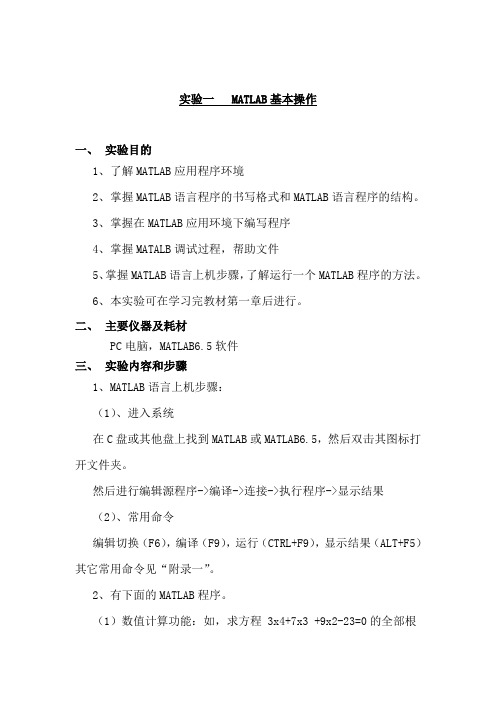
实验一 MATLAB基本操作一、实验目的1、了解MATLAB应用程序环境2、掌握MATLAB语言程序的书写格式和MATLAB语言程序的结构。
3、掌握在MATLAB应用环境下编写程序4、掌握MATALB调试过程,帮助文件5、掌握MATLAB语言上机步骤,了解运行一个MATLAB程序的方法。
6、本实验可在学习完教材第一章后进行。
二、主要仪器及耗材PC电脑,MATLAB6.5软件三、实验内容和步骤1、MATLAB语言上机步骤:(1)、进入系统在C盘或其他盘上找到MATLAB或MATLAB6.5,然后双击其图标打开文件夹。
然后进行编辑源程序->编译->连接->执行程序->显示结果(2)、常用命令编辑切换(F6),编译(F9),运行(CTRL+F9),显示结果(ALT+F5)其它常用命令见“附录一”。
2、有下面的MATLAB程序。
(1)数值计算功能:如,求方程 3x4+7x3 +9x2-23=0的全部根p=[3,7,9,0,-23]; %建立多项式系数向量x=roots(p) %求根(2)绘图功能:如,绘制正弦曲线和余弦曲线x=[0:0.5:360]*pi/180;plot(x,sin(x),x,cos(x));(3)仿真功能:如,请调试上述程序。
3、熟悉MATLAB环境下的编辑命令,具体见附录一。
三、实验步骤1、静态地检查上述程序,改正程序中的错误。
2、在编辑状态下照原样键入上述程序。
3、编译并运行上述程序,记下所给出的出错信息。
4、按照事先静态检查后所改正的情况,进行纠错。
5、再编译执行纠错后的程序。
如还有错误,再编辑改正,直到不出现语法错误为止。
四、实验注意事项1、记下在调试过程中所发现的错误、系统给出的出错信息和对策。
分析讨论对策成功或失败的原因。
2、总结MATLAB程序的结构和书写规则。
五、思考题1、matlab到底有多少功能?2、MATLAB的搜索路径3、掌握使用MATLAB帮助文件实验二 MATLAB 矩阵及其运算一、 实验目的1、了解矩阵的操作,包括矩阵的建立、矩阵的拆分、矩阵分析等2、了解MATLAB 运算,包括算术运算、关系运算、逻辑运算等3、掌握字符串的操作,了解结构数据和单元数据。
MATLAB实验

MATLAB实验一:MATLAB语言基本概念实验实验目的:1. 熟悉MATLAB语言及使用环境;2.掌握MATLAB的常用命令;3.掌握MATLAB的工作空间的使用;4.掌握MATLAB的获得帮助的途径。
5.掌握科学计算的有关方法,熟悉MATLAB语言及其在科学计算中的运用;6.掌握MATLAB的命令运行方式和M文件运行方式;7.掌握矩阵在MATLAB中的运用。
实验方案分析及设计:本次实验主要目的是了解MATLAB的使用环境,以及常用的一些命令的使用;了解矩阵在MATLAB实验中的具体运用,以及相关的一些符号命令的使用。
实验器材:电脑一台,MATLAB软件实验步骤:打开MATLAB程序,将实验内容中的题目依次输入MATLAB中,运行得到并记录结果,最后再对所得结果进行验证。
实验内容及要求:1.熟悉MATLAB的菜单和快捷键的功能2.熟悉MATLAB的命令窗口的使用3.熟悉常用指令的使用format clc clear help lookfor who whos 4.熟悉命令历史窗口的使用5. 熟悉MATLAB工作空间的功能将工作空间中的变量保存为M文件,并提取该文件中的变量6.熟悉MATLAB获取帮助的途径将所有plot开头的函数列出来,并详细给出plotfis函数的使用方法1. 输入 A=[7 1 5;2 5 6;3 1 5],B=[1 1 1; 2 2 2;3 3 3],在命令窗口中执行下列表达式,掌握其含义:A(2, 3) A(:,2) A(3,:) A(:,1:2:3)A(:,3).*B(:,2) A(:,3)*B(2,:) A*BA.*BA^2 A.^2 B/A B./AA=[7 1 5;2 5 6;3 1 5]7 1 52 5 63 1 5>> B=[1 1 1; 2 2 2;3 3 3]1 1 12 2 23 3 3>> A(2, 3)6>> A(:,2)151>> A(3,:)3 1 5>> A(:,1:2:3)7 52 63 5>> A(:,3).*B(:,2)51215>> A(:,3)*B(2,:)10 10 1012 12 1210 10 10>> A*B24 24 2430 30 3020 20 20>> A.*B7 1 54 10 129 3 15>> A^266 17 6642 33 7038 13 46>> A.^249 1 254 25 369 1 25>> B/A0.1842 0.2105 -0.23680.3684 0.4211 -0.47370.5526 0.6316 -0.7105>> B./A0.1429 1.0000 0.20001.0000 0.4000 0.33331.0000 3.0000 0.60002.输入 C=1:2:20,则 C (i )表示什么?其中 i=1,2,3, (10)1到19差为2,i 代表公差3. 试用 help 命令理解下面程序各指令的含义:cleart =0:0.001:2*pi;subplot(2,2,1);polar(t, 1+cos(t))subplot(2,2,2);plot(cos(t).^3,sin(t).^3)subplot(2,2,3);polar(t,abs(sin(t).*cos(t)))subplot(2,2,4);polar(t,(cos(2*t)).^0.5)4计算矩阵⎥⎥⎥⎦⎤⎢⎢⎢⎣⎡897473535与⎥⎥⎥⎦⎤⎢⎢⎢⎣⎡638976242之和。
MATLAB实验指导

MATLAB基础教程实验指导书实验一:Desktop操作桌面基础一、实验目的及要求1、熟悉MATLAB系统的安装流程,掌握MATLAB的启动和退出。
2、掌握MATLAB系统的各命令窗口的功能,熟悉常用选项和工具栏的功能和用途。
3、熟悉简单程序的输入、运行、调试及结果的显示过程。
二、实验内容1、认识MATLAB集成环境:熟悉个操作窗口的功能和用途。
掌握File(文件)、Edit(编辑)、View(显示)、Web(网络)、Window(窗口)和Help(帮助) 等菜单命令的使用。
2、启动和退出MATLAB(1)启动MATLAB的M文件。
在启动MATLAB时,系统可自动执行主M文件matlabrc.m,在matlabrc.m的末尾还会检测是否存在startup.m,如存在则会自动执行它。
在网络系统中,matlabrc.m保留给系统管理员,而各个用户可利用startup.m进行初始设置。
(2)、终止或退出MATLAB。
quit命令可终止MATLAB,但不保存工作空间的内容。
为保存工作空间的内容,可使用save命令。
1、利用save、load命令,保存和恢复工作空间。
用clear命令可清空工作空间。
(1)、工作空间中的变量可以用save命令存储到磁盘文件中。
(2)、用load命令可将变量从磁盘文件读入MATLAB的工作空间。
(3)、用clear命令可清除工作空间中现存的变量。
4、MATLAB的所有图形工具窗体都可以嵌入MATLAB窗体(Dock),也可以从MATLAB窗体中弹出(Undock),例如在MATLAB默认的图形窗体环境下,单击命令行窗体左上角按钮,就可以将MATLAB命令行窗体弹出。
要求分别将命令行窗体(Command Window)、命令行历史窗体(Command History)、当前路径查看器(Current Directory)、工作空间浏览器(Workspace Browser)、帮助(Help)、MATLAB性能剖析工具(Profiler) 从MATLAB窗体中弹出和嵌入MATLAB窗体(Dock)。
Matlab实验及答案

实验一、MATLAB基本操作一、实验目的2.学习使用图形函数计算器命令funtool及其环境。
3. 学习使用help命令进行帮助4. 掌握向量与矩阵的创建以及矩阵的基本操作5. 掌握数组与矩阵的概念二、实验内容熟悉Matlab操作环境,认识命令窗口、内存工作区窗口、历史命令窗口;学会使用format命令调整命令窗口的数据显示格式;学会使用变量和矩阵的输入,并进行简单的计算;掌握数组与矩阵的概念;学会使用help命令进行帮助;学会使用who和whos命令查看内存变量信息;学会使用图形函数计算器funtool;1.命令窗口的简单使用(1)简单矩阵的输入(自由创建)x=[1 3 5;2 4 6]x =1 3 52 4 6(2)求[12+2×(7-4)]÷32的算术运算结果,总结算术运算符先级[12+2*(7-4)]/3^2ans =22.有关向量、矩阵或数组的一些运算(1)设A=15;B=20;求C=A+B与c=a+b的区别A=15;B=20;>> C=A+BC =35>> c=a+bUndefined function or variable 'a'.(2)设A=[1 2 3;4 5 6;7 8 9],B=[9 8 7;6 5 4;3 2 1];求A*B与A.*B,分析原因?(A*B是两个矩阵相乘,A.*B是对应元素相乘)A=[1 2 3;4 5 6;7 8 9];B=[9 8 7;6 5 4;3 2 1];>> A*Bans =30 24 1884 69 54138 114 90>> A.*Bans =9 16 2124 25 2421 16 9(3)设a=10,b=20;求i=a/b与j=a\ba=10;>> b=20;>> i=a/bi =0.5000>> j=a\bj =2(4)设a=[1 -2 3;4 5 -4;5 -6 7]请设计出程序,分别找出小于0的矩阵元素的线性索引以及行列索引(sub2ind/ind2sub)。
MATLAB实验报告
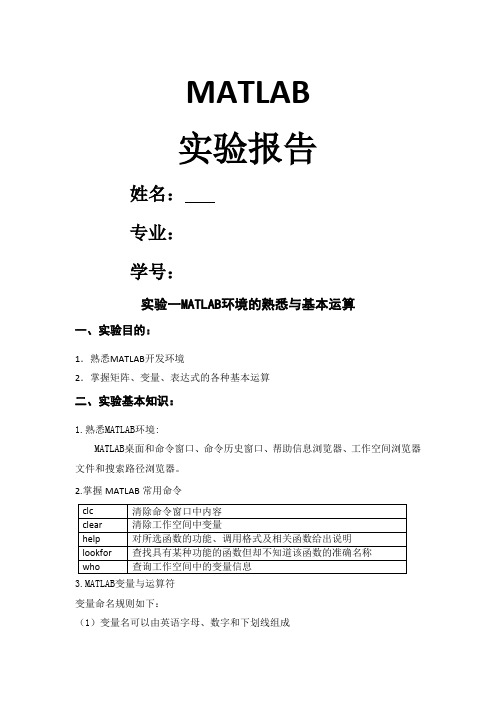
MATLAB实验报告姓名:专业:学号:实验一MATLAB环境的熟悉与基本运算一、实验目的:1.熟悉MATLAB开发环境2.掌握矩阵、变量、表达式的各种基本运算二、实验基本知识:1.熟悉MATLAB环境:MATLAB桌面和命令窗口、命令历史窗口、帮助信息浏览器、工作空间浏览器文件和搜索路径浏览器。
2.掌握MATLAB常用命令3.MATLAB变量与运算符变量命名规则如下:(1)变量名可以由英语字母、数字和下划线组成(2)变量名应以英文字母开头(3)长度不大于31个(4)区分大小写MATLAB中设置了一些特殊的变量与常量,列于下表。
MATLAB运算符,通过下面几个表来说明MATLAB的各种常用运算符表2MATLAB算术运算符表3MATLAB关系运算符表4MATLAB逻辑运算符表5MATLAB特殊运算4.MATLAB的一维、二维数组的寻访表6子数组访问与赋值常用的相关指令格式5.MATLAB的基本运算表7两种运算指令形式和实质内涵的异同表6.MATLAB的常用函数表8标准数组生成函数表9数组操作函数三、实验内容1、学习安装MATLAB软件。
2、学习使用help命令,例如在命令窗口输入helpeye,然后根据帮助说明,学习使用指令eye(其它不会用的指令,依照此方法类推)3、学习使用clc、clear,观察commandwindow、commandhistory和workspace等窗口的变化结果。
4、初步程序的编写练习,新建M-file,保存(自己设定文件名,例如exerc1、exerc2、exerc3……),学习使用MATLAB的基本运算符、数组寻访指令、标准数组生成函数和数组操作函数。
注意:每一次M-file的修改后,都要存盘。
四、实验结果练习A:(1)helprand,然后随机生成一个2×6的数组,观察commandwindow、commandhistory和workspace等窗口的变化结果。
MATLAB数学实验100例题解
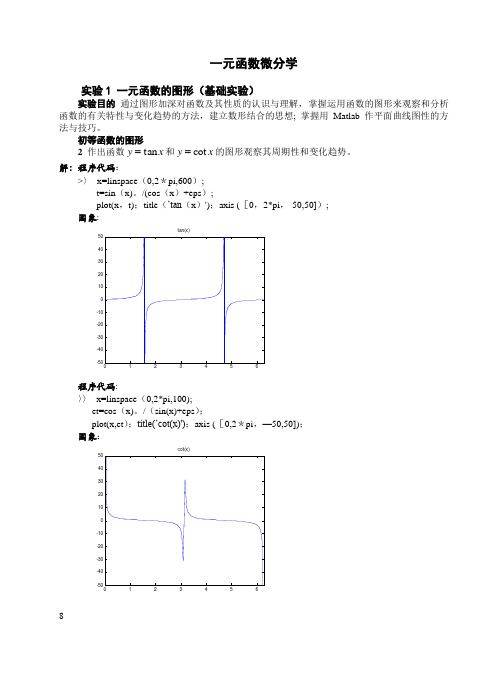
一元函数微分学实验1 一元函数的图形(基础实验)实验目的 通过图形加深对函数及其性质的认识与理解, 掌握运用函数的图形来观察和分析 函数的有关特性与变化趋势的方法,建立数形结合的思想; 掌握用Matlab 作平面曲线图性的方法与技巧。
初等函数的图形2 作出函数x y tan =和x y cot =的图形观察其周期性和变化趋势。
解:程序代码:>〉 x=linspace (0,2*pi,600); t=sin (x)。
/(cos (x )+eps );plot(x ,t);title (’tan (x )');axis ([0,2*pi ,-50,50]); 图象:程序代码: 〉〉 x=linspace (0,2*pi,100); ct=cos (x)。
/(sin(x)+eps ); plot(x,ct );title(’cot(x)');axis ([0,2*pi ,—50,50]); 图象:cot(x)4在区间]1,1[-画出函数xy 1sin =的图形。
解:程序代码:>> x=linspace (-1,1,10000);y=sin(1。
/x ); plot (x,y ); axis ([-1,1,—2,2]) 图象:二维参数方程作图6画出参数方程⎩⎨⎧==t t t y tt t x 3cos sin )(5cos cos )(的图形:解:程序代码:>〉 t=linspace(0,2*pi,100); plot(cos(t ).*cos (5*t ),sin(t )。
*cos(3*t)); 图象:极坐标方程作图8 作出极坐标方程为10/t e r =的对数螺线的图形. 解:程序代码:〉〉 t=0:0.01:2*pi ; r=exp (t/10);polar(log(t+eps ),log (r+eps)); 图象:90270分段函数作图10 作出符号函数x y sgn =的图形。
MATLAB实验报告
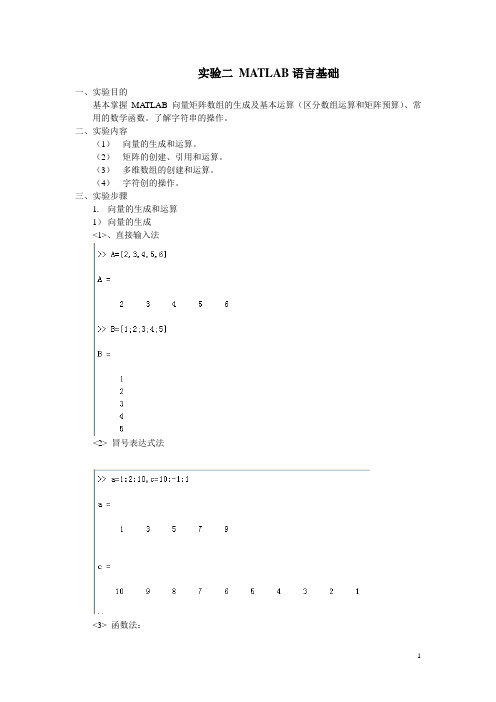
实验二MATLAB语言基础一、实验目的基本掌握MA TLAB向量矩阵数组的生成及基本运算(区分数组运算和矩阵预算)、常用的数学函数。
了解字符串的操作。
二、实验内容(1)向量的生成和运算。
(2)矩阵的创建、引用和运算。
(3)多维数组的创建和运算。
(4)字符创的操作。
三、实验步骤1.向量的生成和运算1)向量的生成<1>、直接输入法<2> 冒号表达式法<3> 函数法:Linspace()是线性等分函数,logspace()是对数等分函数。
2)向量的运算1>维数相同的行、列向量之间可以相加减,标量可以与向量直接相乘除。
2>向量的点积与叉积运算E1和E2虽然表达式相同,但E1是标量,E2是矩阵。
2.矩阵的创建、引用和运算1)矩阵的创建和引用矩阵是由m*n元素构成的矩形结构,行向量和列向量是矩阵的特殊形式。
1>直接输入法:2>抽取法:包括单下标抽取和全下表抽取两种方式,且两种方式抽取的元素都必须以小括号括起来。
3>函数法:利用ones(m;n)创建全1矩阵,zeros()创建全0矩阵,eyes()创建单位矩阵等等。
4>拼接法:纵向拼接横向拼接5>利用拼接函数cat()repmat()和变形函数reshape()>> A1=[1 2 3;9 8 7 ;4 5 6];A2=A1.';>> cat(1,A1,A2) 沿行向拼接ans =1 2 39 8 74 5 61 9 42 8 53 7 6>> cat(2,A1,A2) 沿列向拼接ans =1 2 3 1 9 49 8 7 2 8 54 5 6 3 7 6>> repmat(A1,2,2)ans =1 2 3 1 2 39 8 7 9 8 74 5 6 4 5 61 2 3 1 2 39 8 7 9 8 74 5 6 4 5 6> A=linspace(2,18,9)A =2 4 6 8 10 12 14 16 18 >> reshape(A,3,3)ans =2 8 144 10 166 12 182)矩阵的运算练习(1)用矩阵除法求下列方程组的解x=[x1;x2;x3]>> A=[6 3 4;-2 5 7;8 -1 -3];B=[3;-4;-7];X=A\BX =1.0200-14.00009.7200(2)求矩阵的秩A=[6 3 4;-2 5 7;8 -1 -3];>> rank(A)ans =3[X,lamda]=eig(A)X =0.8013 -0.1094 -0.16060.3638 -0.6564 0.86690.4749 0.7464 -0.4719lamda =9.7326 0 00 -3.2928 00 0 1.5602(3)矩阵的开方>> B=sqrtm(A)B =2.2447 + 0.2706i 0.6974 - 0.1400i 0.9422 - 0.3494i -0.5815 + 1.6244i 2.1005 - 0.8405i 1.7620 - 2.0970i1.9719 - 1.8471i -0.3017 + 0.9557i 0.0236 +2.3845i (4)矩阵的指数与对数:> C=expm(A)C =1.0e+004 *1.0653 0.5415 0.63230.4830 0.2465 0.28760.6316 0.3206 0.3745>> logm(C)ans =6.0000 3.0000 4.0000-2.0000 5.0000 7.00008.0000 -1.0000 -3.0000(6)矩阵的转置D=A'D =6 -2 83 5 -14 7 -3(7)矩阵的提取与翻转:通过各种特定函数如triu(A)、tril(A),diag(A)、flipud (A)、fliplr(A)等等。
matlab实验报告
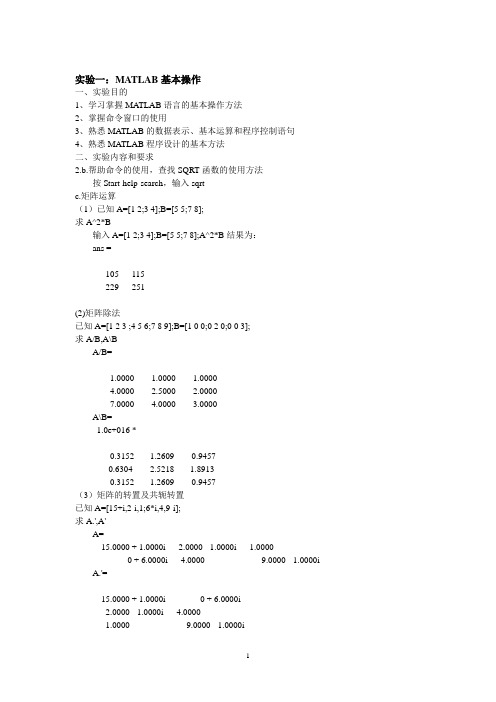
实验一:MATLAB基本操作一、实验目的1、学习掌握MA TLAB语言的基本操作方法2、掌握命令窗口的使用3、熟悉MA TLAB的数据表示、基本运算和程序控制语句4、熟悉MA TLAB程序设计的基本方法二、实验内容和要求2.b.帮助命令的使用,查找SQRT函数的使用方法按Start-help-search,输入sqrtc.矩阵运算(1)已知A=[1 2;3 4];B=[5 5;7 8];求A^2*B输入A=[1 2;3 4];B=[5 5;7 8];A^2*B结果为:ans =105 115229 251(2)矩阵除法已知A=[1 2 3 ;4 5 6;7 8 9];B=[1 0 0;0 2 0;0 0 3];求A/B,A\BA/B=1.0000 1.0000 1.00004.0000 2.5000 2.00007.0000 4.0000 3.0000A\B=1.0e+016 *0.3152 -1.2609 0.9457-0.6304 2.5218 -1.89130.3152 -1.2609 0.9457(3)矩阵的转置及共轭转置已知A=[15+i,2-i,1;6*i,4,9-i];求A.',A'A=15.0000 + 1.0000i 2.0000 - 1.0000i 1.00000 + 6.0000i 4.0000 9.0000 - 1.0000iA.'=15.0000 + 1.0000i 0 + 6.0000i2.0000 - 1.0000i 4.00001.0000 9.0000 - 1.0000iA'=15.0000 - 1.0000i 0 - 6.0000i2.0000 + 1.0000i 4.00001.0000 9.0000 + 1.0000i(4)使用冒号选出指定元素已知A=[1 2 3;4 5 6;7 8 9];求A中第三列前两个元素;A中所有第二行的元素A =1 2 34 5 67 8 9求A中第三列前两个元素:A([1,2],3)ans =36求A中所有第二行的元素:A(2,1:1:end)ans =4 5 6(5)方括号[]用magic函数生成一个4阶魔方矩阵,删除该矩阵的第四列magic(4)ans =16 2 3 135 11 10 89 7 6 124 14 15 1a=ans;a(:,[1,2,3])ans =16 2 35 11 109 7 64 14 153..多项式(1)求多项式p(X)=x^3-2x-4的根(2)已知A=[1.2 3 5 0.9;5 1.7 5 6;3 9 0 1;1 2 3 4]求矩阵A的特征多项式;求矩阵多项式中未知数为20时的值;把矩阵A作为未知数代入到多项式中;(1)a=[1,0,-2,-4]x=roots(a)x =2.0000-1.0000 + 1.0000i-1.0000 - 1.0000i(2)求特征多项式系数:A=[1.2 3 5 0.9;5 1.7 5 6;3 9 0 1;1 2 3 4]p=poly(A)p =1.0000 -6.9000 -77.2600 -86.1300 604.5500求矩阵多项式中未知数为20时的值:c=polyval(p,20)c =7.2778e+004把矩阵A作为未知数代入到多项式中:c=polyval(p,A)c =1.0e+003 *0.3801 -0.4545 -1.9951 0.4601-1.9951 0.2093 -1.9951 -2.8880-0.4545 -4.8978 0.6046 0.43530.4353 0.0840 -0.4545 -1.16174、基本程序设计(1)编写命令文件:计算1+2+3+……+n<2000;n=0;s=0;while s<2000n=n+1;s=s+n;endn=n-1n =62(2)编写函数文件:分别用for和while循环结构编写程序,求2的0到n次幂的和。
MATLAB实验

MATLAB实验实验⼀MATLAB操作基础⼀、实验⽬的1、熟悉MATLAB的操作环境及基本操作⽅法。
2、掌握MATLAB的搜索路径及其设置⽅法。
3、熟悉MATLAB帮助信息的查阅⽅法。
⼆、实验内容1、先建⽴⾃⼰的⼯作⽬录,再将⾃⼰的⼯作⽬录设置到MATLAB搜索路径下,再试验⽤help命令能否查询到⾃⼰的⼯作⽬录。
2、在MATLAB环境下验证例1-1⾄1-4,并完成以下题⽬:(1)绘制右图所⽰图形(23、利⽤MATLAB的帮助功能分别查询inv,plot、max、round等函数的功能及⽤法。
4、在⼯作空间建⽴⼀个变量a ,同时在当前⽬录下建⽴⼀个M⽂件:a.m,试在命令窗⼝输⼊a,观察结果,并解释原因。
三、思考练习1、help命令和lookfor命令有什么区别?2、什么是⼯作空间?假定有变量A与B存在于⼯作空间中,如何⽤命令保存这两个变量?下次重新进⼊MATLAB后,⼜如何装载这两个变量?实验⼆MATLAB数值计算⼀、实验⽬的1、掌握MATLAB变量和数据操作2、掌握MATLAB矩阵及其操作3、掌握MATLAB矩阵运算⼆、实验内容1、求下列表达⽰的值(1)6(10.3424510)w-=+?(2)22tan()b ca eabcxb c aππ++-+=++,其中a=3.5 ,b=5 ,c=-9.8(3)21ln(2tz e t=+,其中213[]50.65it-=-2、已知1540783617A--=??,831253320B-=??-??求下列表达式的值:(1)A+6B和2A B I-+(I为单位矩阵)(2)A*B、A.*B和B*A(3)A/B及B\A(4)[A,B] 和[A([1,3],:) ; B^2]3、建⽴⼀个均值为3,⽅差为1的10*10的正态分布随机矩阵,并将矩阵中⼤于0的元素置1,⼩于0的置0.4、当[34,,,,,,0]A NaN Inf Inf pi eps=--时,求函数all(A),any(A),isnan(A),isinf(A),isfinite(A)的值。
MATLAB实验指导书

实验一:MATLAB的基本操作一、实验目的:1.熟悉MATLAB操作环境2.熟悉MATLAB的帮助3.熟悉MATLAB矩阵的操作4.熟悉MATLAB基本运算二、实验内容:1.自行设计试题,说明三角函数是按弧度还是按角度计算。
2.找出取整的函数,并自行设计试题,说明它们的区别。
3.自行设计试题,说明如何给矩阵按列符值。
4.自行设计试题,建一个5X5矩阵,然后将第一行乘1,第二行乘2,第三行乘3,第四行乘4,第五行乘5。
5.设计编写程序(命令),解方程3x5-7x4+5x2+2x-18=0。
6.自行设计试题,说明eval()函数的功能。
三、实验原理:ceil(x)= -4 -2 0 2 5 7fix(x) = -4 -2 0 1 4 6floor(x) = -5 -3 -1 1 4 6round(x) = -5 -2 0 1 5 72、系统的在线帮助help 命令:(1).当不知系统有何帮助内容时,可直接输入help以寻求帮助:>> help(回车)(2).当想了解某一主题的内容时,如输入:>> help syntax(了解Matlab的语法规定)(3).当想了解某一具体的函数或命令的帮助信息时,如输入:>> help sqrt (了解函数sqrt的相关信息)lookfor命令现需要完成某一具体操作,不知有何命令或函数可以完成,如输入:>> lookfor line (查找与直线、线性问题有关的函数)3、常量与变量系统的变量命名规则:变量名区分字母大小写;变量名必须以字母打头,其后可以是任意字母,数字,或下划线的组合。
此外,系统内部预先定义了几个有特殊意义和用途的变量,见下表:数值型向量(矩阵)的输入(1).任何矩阵(向量),可以直接按行方式...输入每个元素:同一行中的元素用逗号(,)或者用空格符来分隔;行与行之间用分号(;)分隔。
所有元素处于一方括号([ ])内;例1-1:>> Time = [11 12 1 2 3 4 5 6 7 8 9 10]>> X_Data = [2.32 3.43;4.37 5.98](2).系统中提供了多个命令用于输入特殊的矩阵:上面函数的具体用法,可以用帮助命令help得到。
matlab 实验报告

matlab 实验报告Matlab实验报告引言:Matlab是一种强大的数值计算和可视化软件,广泛应用于科学、工程和经济等领域。
本实验报告将介绍我在使用Matlab进行实验过程中的一些经验和结果。
实验一:矩阵运算在这个实验中,我使用Matlab进行了矩阵运算。
首先,我创建了一个3x3的矩阵A和一个3x1的矩阵B,并进行了矩阵相乘运算。
通过Matlab的矩阵乘法运算符*,我得到了一个3x1的结果矩阵C。
接着,我对矩阵C进行了转置操作,得到了一个1x3的矩阵D。
最后,我计算了矩阵C和矩阵D的点积,并将结果输出。
实验二:数据可视化在这个实验中,我使用Matlab进行了数据可视化。
我选择了一组实验数据,包括时间和温度两个变量。
首先,我将数据存储在一个矩阵中,并使用Matlab的plot函数将时间和温度之间的关系绘制成曲线图。
接着,我使用Matlab的xlabel、ylabel和title函数添加了横轴、纵轴和标题。
最后,我使用Matlab的legend函数添加了图例,以便更好地理解图表。
实验三:数值积分在这个实验中,我使用Matlab进行了数值积分。
我选择了一个函数f(x)进行积分计算。
首先,我使用Matlab的syms函数定义了符号变量x,并定义了函数f(x)。
接着,我使用Matlab的int函数对函数f(x)进行积分计算,并将结果输出。
为了验证结果的准确性,我还使用了Matlab的diff函数对积分结果进行了求导操作,并与原函数f(x)进行了比较。
实验四:信号处理在这个实验中,我使用Matlab进行了信号处理。
我选择了一个音频文件,并使用Matlab的audioread函数读取了该文件。
接着,我使用Matlab的fft函数对音频信号进行了傅里叶变换,并将结果绘制成频谱图。
为了进一步分析信号的特征,我还使用了Matlab的spectrogram函数绘制了信号的时频图。
通过对信号的频谱和时频图的观察,我可以更好地理解信号的频率和时域特性。
matlab实验一实验报告
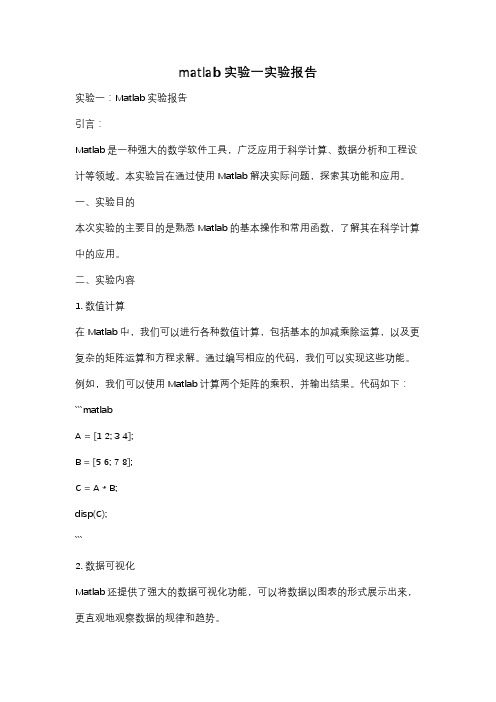
matlab实验一实验报告实验一:Matlab实验报告引言:Matlab是一种强大的数学软件工具,广泛应用于科学计算、数据分析和工程设计等领域。
本实验旨在通过使用Matlab解决实际问题,探索其功能和应用。
一、实验目的本次实验的主要目的是熟悉Matlab的基本操作和常用函数,了解其在科学计算中的应用。
二、实验内容1. 数值计算在Matlab中,我们可以进行各种数值计算,包括基本的加减乘除运算,以及更复杂的矩阵运算和方程求解。
通过编写相应的代码,我们可以实现这些功能。
例如,我们可以使用Matlab计算两个矩阵的乘积,并输出结果。
代码如下:```matlabA = [1 2; 3 4];B = [5 6; 7 8];C = A * B;disp(C);```2. 数据可视化Matlab还提供了强大的数据可视化功能,可以将数据以图表的形式展示出来,更直观地观察数据的规律和趋势。
例如,我们可以使用Matlab绘制一个简单的折线图,来展示某个物体在不同时间下的位置变化。
代码如下:```matlabt = 0:0.1:10;x = sin(t);plot(t, x);xlabel('Time');ylabel('Position');title('Position vs. Time');```3. 图像处理Matlab还可以进行图像处理,包括图像的读取、处理和保存等操作。
我们可以通过Matlab对图像进行增强、滤波、分割等处理,以及进行图像的压缩和重建。
例如,我们可以使用Matlab读取一张图片,并对其进行灰度化处理。
代码如下:```matlabimg = imread('image.jpg');gray_img = rgb2gray(img);imshow(gray_img);```三、实验结果与分析在本次实验中,我们成功完成了数值计算、数据可视化和图像处理等任务。
MATLAB实验报告
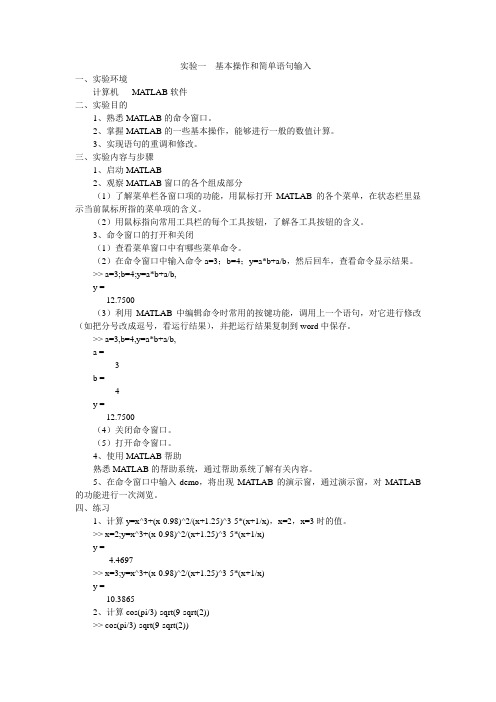
实验一基本操作和简单语句输入一、实验环境计算机MATLAB软件二、实验目的1、熟悉MATLAB的命令窗口。
2、掌握MATLAB的一些基本操作,能够进行一般的数值计算。
3、实现语句的重调和修改。
三、实验内容与步骤1、启动MATLAB2、观察MATLAB窗口的各个组成部分(1)了解菜单栏各窗口项的功能,用鼠标打开MA TLAB的各个菜单,在状态栏里显示当前鼠标所指的菜单项的含义。
(2)用鼠标指向常用工具栏的每个工具按钮,了解各工具按钮的含义。
3、命令窗口的打开和关闭(1)查看菜单窗口中有哪些菜单命令。
(2)在命令窗口中输入命令a=3;b=4;y=a*b+a/b,然后回车,查看命令显示结果。
>> a=3;b=4;y=a*b+a/b,y =12.7500(3)利用MATLAB中编辑命令时常用的按键功能,调用上一个语句,对它进行修改(如把分号改成逗号,看运行结果),并把运行结果复制到word中保存。
>> a=3,b=4,y=a*b+a/b,a =3b =4y =12.7500(4)关闭命令窗口。
(5)打开命令窗口。
4、使用MATLAB帮助熟悉MATLAB的帮助系统,通过帮助系统了解有关内容。
5、在命令窗口中输入demo,将出现MA TLAB的演示窗,通过演示窗,对MATLAB 的功能进行一次浏览。
四、练习1、计算y=x^3+(x-0.98)^2/(x+1.25)^3-5*(x+1/x),x=2,x=3时的值。
>> x=2;y=x^3+(x-0.98)^2/(x+1.25)^3-5*(x+1/x)y =-4.4697>> x=3;y=x^3+(x-0.98)^2/(x+1.25)^3-5*(x+1/x)y =10.38652、计算cos(pi/3)-sqrt(9-sqrt(2))>> cos(pi/3)-sqrt(9-sqrt(2))ans =-2.25423、已知:a=3,A=4,b=a^2,B=b^2-1,c=a+A-2*B,C=a+B+2*c,求:C>> a=3;A=4;b=a^2;B=b^2-1;c=a+A-2*B;C=a+B+2*cC =-2234、复数z1=1+3*i,z2=1+2*i,z3=2*exp((pi/6)*i),求z=(z1*z2)/z3>> z1=1+3*i;z2=1+2*i;z3=2*exp((pi/6)*i);z=(z1*z2)/z3z =-0.9151 + 3.4151i实验二矩阵和数组的操作一、实验环境计算机MATLAB软件二、实验目的1、掌握矩阵和数组的一般操作,包括创建、保存、修改和调用等。
Matlab实验报告
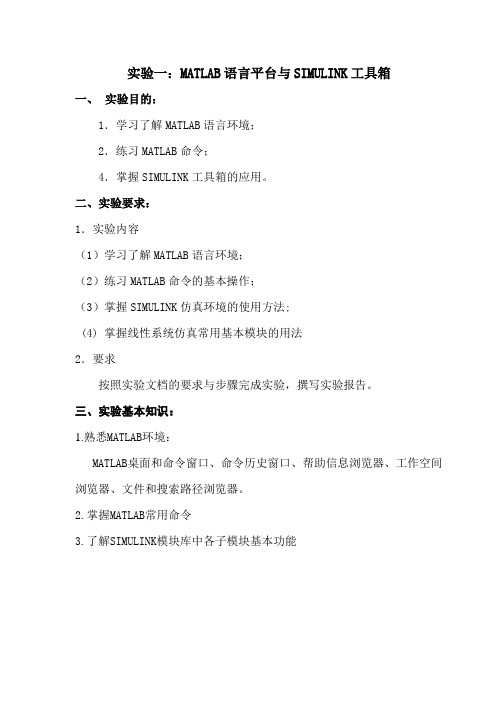
实验一:MATLAB语言平台与SIMULINK工具箱一、实验目的:1.学习了解MATLAB语言环境;2.练习MATLAB命令;4.掌握SIMULINK工具箱的应用。
二、实验要求:1.实验内容(1)学习了解MATLAB语言环境;(2)练习MATLAB命令的基本操作;(3)掌握SIMULINK仿真环境的使用方法;(4) 掌握线性系统仿真常用基本模块的用法2.要求按照实验文档的要求与步骤完成实验,撰写实验报告。
三、实验基本知识:1.熟悉MATLAB环境:MATLAB桌面和命令窗口、命令历史窗口、帮助信息浏览器、工作空间浏览器、文件和搜索路径浏览器。
2.掌握MATLAB常用命令3.了解SIMULINK模块库中各子模块基本功能四、实验内容:1.学习使用help命令,例如在命令窗口输入help eye,然后根据帮助说明,学习使用指令eye(其它不会用的指令,依照此方法类推)help eyeEYE Identity matrix.EYE(N) is the N-by-N identity matrix.EYE(M,N) or EYE([M,N]) is an M-by-N matrix with 1's onthe diagonal and zeros elsewhere.EYE(SIZE(A)) is the same size as A.EYE with no arguments is the scalar 1.EYE(M,N,CLASSNAME) or EYE([M,N],CLASSNAME) is an M-by-N matrix with 1'sof class CLASSNAME on the diagonal and zeros elsewhere.Example:x = eye(2,3,'int8');See also speye, ones, zeros, rand, randn.Reference page in Help browserdoc eyeA=eye(3)A=1 0 00 1 00 0 12.任意创建3个变量,分别为数值、矩阵、字符串,保存到mydat.mat文件,再把my_data.mat文件中的变量读取到MatLab工作空间内;查找已创建变量的信息,删除变量;学习使用clc、clear,观察command window、command history和workspace等窗口的变化结果。
- 1、下载文档前请自行甄别文档内容的完整性,平台不提供额外的编辑、内容补充、找答案等附加服务。
- 2、"仅部分预览"的文档,不可在线预览部分如存在完整性等问题,可反馈申请退款(可完整预览的文档不适用该条件!)。
- 3、如文档侵犯您的权益,请联系客服反馈,我们会尽快为您处理(人工客服工作时间:9:00-18:30)。
a=20; b=-2; c=0; d=’Test’;
(13)isinf(a/b)(14)isinf(a/c)(15)a>b&ischar(d)(16)isempty(c)
5.Writea Matlab program to solve the function ,where x is a number <1. Use an if structure to verify that the value passed to the program is legal. If the value of x is legal, caculate y(x). If not ,write a suitable error message and quit.
counter=1;
for(i=-9:0.5:9)
if i<0
data(counter)=3*i^2+5;
else
data(counter)=-3*i^2+5;
end
counter=counter+1;
end
i=-9:0.5:9;
plot(i,data);
Result:
练习1
(1)
>> limit((n)^(1/n),n,inf)
4)4) array1([1 1],:)
ans =
1.1000 0 2.1000 -3.5000 6.0000
1.1000 0 2.1000 -3.5000 6.0000
4.Give the answer of the following operations
1)a+b
ans =
3 -3
-1 4
2)a*d
x=-pi:pi/20:pi;y=sin(x);plot(x,y);grid on;
title('Subplot 1 Title');
subplot(2,1,2);
x=-pi:pi/20:pi;y=cos(x);plot(x,y);grid on;
title('Subplot 2 Title');
3.Polar Plotsexercise
1) a=1:2:5;1 3 5
2) b=[a’a’a’];
b =
1 1 1
3 3 3
5 5 5
3) c=b(1:2:3,1:2:3);
c =
1 1
5 5
4) d=a+b(2,:)
d =
4 6 8
5) w=[zeros(1,3)ones(3,1)’3:5’]
w =
0 0 0 1 1 1 3 4 5
3.Give the answer of the sub-arrays
>> f=(1/2)^x;
>> fx=limit(f,x,inf)
fx =
0
例3
X>0时
>> syms x
>> f=(((1+x)^(1/x))/(exp(1)))^(1/x);
>> fx=limit(f,x,0,'right')
fx =
0
X<0时
>> exp(-1/2)
ans =
1.6065
例4
>> syms x
1)array1(3,:);
ans =
2.1000 0.1000 0.3000 -0.4000 1.3000
2)2) array1(:,3);
ans =
2.1000
-6.6000
0.3000
0
3)3) array1(1:2:3,[3 3 4])
ans =
2.1000 2.1000 -3.5000
0.3000 0.3000 -0.4000
g=0.5;
theta=0:pi/20:2*pi;
gain=2*g*(1+cos(theta));
polar(theta,gain,'r-');
title('\fontsize{20} \bfGain versus angle \theta');
4.Assume that a,b,c, and d are defined, and evaluate the following expression.
x=-pi:pi/20:pi;
y1=sin(x);y2=cos(x);plot(x,y1, 'b-');hold on;
plot(x,y2, 'k--');hold off;
legend ('sinx', 'cosx')
2.Figure command exercise
figure(1);
subplot(2,1,1);
subplot(2,2,3);semilogy(x,y);grid on;
subplot(2,2,4);loglog(x,y);grid on;
4.Edit & Run the m-file
% test max and plot function
volts=120;rs=50;rl=1:0.1:100;
ans =
-1/8
例2
(1)
>> syms x
>> y=(1/2)^x;
>> ezplot(y)
(2)
>> syms x
>> f=(1/2)^x;
>> fx=limit(f,x,inf)
fx =
0
>> syms x
>> f=(1/2)^x;
>> fx=limit(f,x,-inf)
fx =
inf
>> syms x
1.Give the answer of the following questions for the array
1)What is the size of array1?4 5
2)What is the value of array1(4,1)?-1.4
3)What is the size and value of array1(:,1:2)?4 2
Plot the amplitude and phase of function for
t=0:0.01:4;
f=(0.5-0.25*i)*t-1.0;
figure(1);
plot(t,abs(f));
title('amplitude response');
figure(2);
plot(t,angle(f));
(1)
>> syms x
>> y=log(sin((x^2+1)^(1/2)));
>> diff(y)
ans =
cos((1+x^2)^(1/2))/(1+x^2)^(1/2)*x/sin((1+x^2)^(1/2))
>> subs(diff(y),x,0)
ans =
0
(2)
>> syms x
>> y=exp(atan(1/x))
a=20; b=-2; c=0; d=1;
(1)a>b;(2)b>d;(3)a>b&c>d;(4)a==b;(5)a&b>c;6)~~b;
a=2; b=[1 –2;-0 10]; c=[0 1;2 0]; d=[-2 1 2;0 1 0];
(7)~(a>b)(8)a>c&b>c(9)c<=d
a=2; b=3; c=10; d=0;
PART III: (需提交实验报告)
1.
3.Write outm. file and plot the figureswith grids
Assume that the complex function f(t) is defined by the equation
f(t)=(0.5-0.25i)t-1.0
PART I:下列选择练习,不需提交实验报告
1.Edit & Run the m-file
% test stepresponsefunction
wn=6;kosi=[0.1:0.1:1.0 2];
figure(1);hold on
for kos=kosi
num=wn^2;den=[1,2*kos*wn,wn.^2];step(num,den)
end
hold off;
2.Edit & Run the m-file
% test plot function
x=0:pi/20:3*pi;y1=sin(x);y2=2*cos(2*x);plot(x,y1,'rv:',x,y2,'bo--');
title('Plot the Line of y=sin(2x) and its derivative');xlabel('X axis');ylabel('Y axis');
y=exp(1/(x-1))
limit(y,x,0,'right')
ezplot(y,[0,pi])
y =
exp(1/(x-1))
